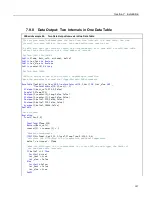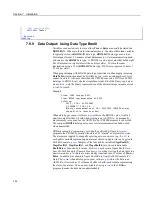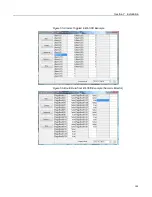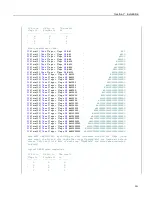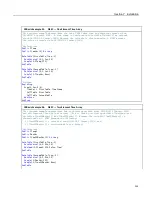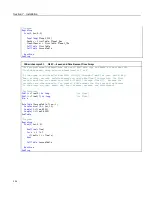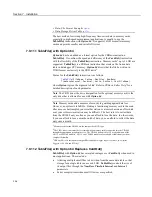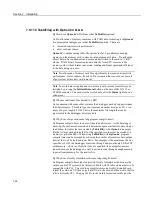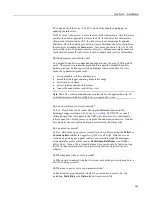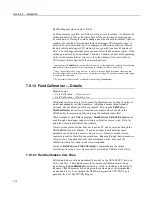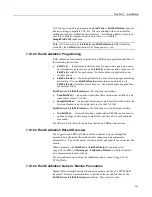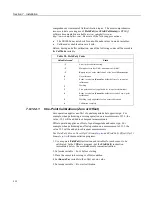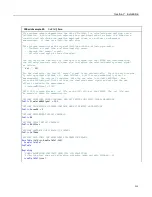
Section 7. Installation
Q:
What happens when a card is filled?
A:
If the memory card fills, new data are written over oldest data. A card must be
exchanged before it fills, or the oldest data will be overwritten by incoming new
records and lost. During the card exchange, once the old card is removed, the new
card must be inserted before the data table in datalogger CPU memory rings
2
, or
data will be overwritten and lost. For example, consider an application wherein
the data table in datalogger CPU memory has a capacity for about 45 minutes of
data
3
. The exchange must take place anytime before the 45 minutes expire. If the
exchange is delayed by an additional 5 minutes, 5 minutes of data at the beginning
of the last 45 minute interval (since it is the oldest data) will be overwritten in
CPU memory before transfer to the new card and lost.
1
Other options of
TableFile()
do not pre-allocate memory, so they should be avoided when collecting
high-frequency time-series data. More information is available in
CRBasic Editor Help
.
2
"rings": the datalogger has a ring memory. In other words, once filled, rather than stopping when
full, oldest data are overwritten by new data. In this context, "rings" designates when new data begins
to overwrite the oldest data.
3
CPU data table fill times can be confirmed in the datalogger
Status
table.
7.9.12 Field Calibration — Details
Related Topics:
•
Field Calibration — Overview
(p. 73)
•
Field Calibration — Details
(p. 210)
Calibration increases accuracy of a sensor by adjusting or correcting its output to
match independently verified quantities. Adjusting a sensor output signal is
preferred, but not always possible or practical. By using the
FieldCal()
or
FieldCalStrain()
instruction, a linear sensor output can be corrected in the
CR1000 after the measurement by adjusting the multiplier and offset.
When included in the CRBasic program,
FieldCal()
and
FieldCalStrain()
can be
used through a datalogger support software
calibration wizard
(p. 509).
Help for
using the wizard is available in the software.
A more arcane procedure that does not require a PC can be executed though the
CR1000KD Keyboard / Display. If you do not have a keyboard, the same
procedure can be done in a
numeric monitor
(p. 521).
Numeric monitor screen
captures are used in the following procedures. Running through these procedures
will give you a foundation for how field calibration works, but use of the
calibration wizard for routine work is recommended.
Syntax of
FieldCal()
and
FieldCalStrain()
is summarized in the section
Calibration Functions
(p. 598).
More detail is available in
CRBasic Editor Help
.
7.9.12.1 Field Calibration CAL Files
Calibration data are stored automatically, usually on the CR1000 CPU: drive, in
CAL (.cal) files. These data become the source for calibration factors when
requested by the
LoadFieldCal()
instruction. A file is created automatically on
the same CR1000 memory drive and given the same name as the program that
creates and uses it. For example, the CRBasic program file CPU:MyProg.cr1
generates the CAL file CPU:MyProg.cal.
210
Summary of Contents for CR1000
Page 2: ......
Page 4: ......
Page 6: ......
Page 32: ......
Page 36: ......
Page 38: ......
Page 40: ......
Page 60: ...Section 4 System Quickstart Figure 16 PC200W View Line Graph 60 ...
Page 96: ......
Page 98: ...98 ...
Page 302: ......
Page 453: ...Section 8 Operation Figure 115 Using the Keyboard Display 453 ...
Page 456: ...Section 8 Operation Figure 118 Real Time Custom 456 ...
Page 457: ...Section 8 Operation 8 8 1 3 Final Memory Tables Figure 119 Final Memory Tables 457 ...
Page 458: ...Section 8 Operation 8 8 2 Run Stop Program Figure 120 Run Stop Program 458 ...
Page 460: ...Section 8 Operation Figure 122 File Edit 460 ...
Page 461: ...Section 8 Operation 8 8 4 PCCard Memory Card Display Figure 123 PCCard CF Card Display 461 ...
Page 478: ......
Page 506: ......
Page 536: ......
Page 636: ......
Page 642: ......
Page 644: ......
Page 676: ......
Page 677: ......


